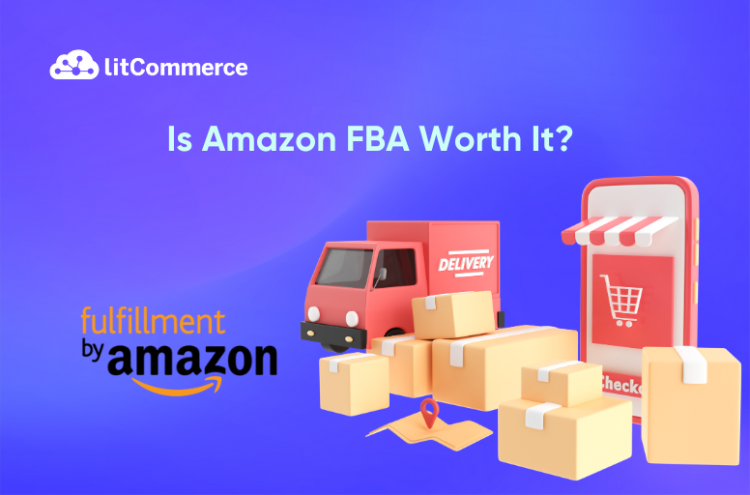Is Amazon FBA worth it? In short: Yes. But let’s explore why.
Amazon continues to be a dominant player in the eCommerce market, generating an impressive $574 billion in revenue in 2023, up from $514 billion in 2022. Notably, nearly 23% of that revenue is driven by third-party sellers, with 82% of those sellers utilizing Fulfillment by Amazon (FBA) to manage their orders. This shows how important FBA is in Amazon’s business strategy and why it’s such a valuable tool for sellers.
In this article, we’ll delve into why selling on Amazon FBA remains a profitable venture in 2025 and beyond.
Is Amazon FBA Worth It?
Yes, Amazon FBA is still worth it in due to its massive customer base, reliable logistics, and Prime benefits, which boost visibility and sales. However, competition from low-cost platforms like Shein and Temu means you must focus on quality products and effective marketing to stand out.
Additionally, leveraging Amazon’s tools like PPC ads, enhanced brand content, and reviews is crucial for standing out. Despite challenges, for sellers with a strategic approach, Amazon FBA can still be highly profitable and scalable in the current market.
Is selling on Amazon FBA Still Profitable?
Selling on Amazon FBA (Fulfillment by Amazon) is still a profitable opportunity in 2025, but several factors can influence how successful you’ll be. Many sellers report monthly earnings between $1,000 and $25,000, with some reaching annual profits of $12,000 to $300,000.
About 40% of sellers fall into the $1,000 to $25,000 monthly sales range, and roughly 64% become profitable within their first year. However, how quickly you hit profitability depends on key factors like the products you choose, the level of competition, and how well you manage your costs.
One of the biggest perks of Amazon FBA is the convenience it offers. Since Amazon takes care of storing, packing, and shipping your products, you’re free to focus on finding great products and marketing them effectively. This can save you a ton of time and take the headache out of logistics.
On top of that, FBA products qualify for Prime shipping, which can significantly boost sales because Prime members love their fast shipping. The “Fulfilled by Amazon” label also adds credibility, making it easier for you to win over customers who trust Amazon’s fulfillment process.
That said, there are some challenges to be aware of. One of the biggest is the rising fees. In 2024, FBA fees have gone up, and they include storage costs and fulfillment charges. Combined with referral fees, these can eat into your profits, sometimes accounting for 30-40% of your product’s price. This means you need to pay close attention to your profit margins before jumping in.
Plus, Amazon’s marketplace is more competitive than ever, so standing out from the crowd is crucial. Whether it’s through product quality, better branding, or unique selling points, you’ll need to find a way to differentiate your products from the competition.
In the end, selling on Amazon FBA is still a great option for many entrepreneurs in 2025, but success doesn’t happen by accident. You’ll need to do thorough market research and have a solid financial plan before diving in.
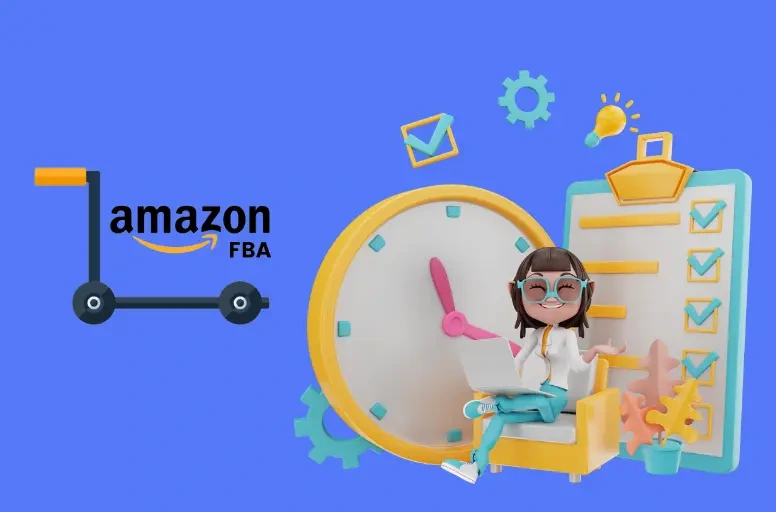
Pros and Cons of Amazon FBA
Amazon FBA is a powerful business model that opens the door to selling products online with ease, offering access to Amazon’s massive customer base and streamlined logistics. However, like any business model, FBA comes with its advantages and disadvantages. To help you decide whether it’s the right fit for your business, let’s break down the key pros and cons of selling through Amazon FBA.
Pros of Amazon FBA
- Simplified fulfillment. With Amazon FBA, you can outsource logistics, allowing you to focus on product sourcing and growing your business. This is especially beneficial if you’re a new seller or have limited resources.
- Increased Buy Box opportunities. As an FBA seller, you often have a better chance of winning the Featured Offer (Buy Box), which can lead to increased visibility and higher sales.
- Fast and free shipping: Your products enrolled in FBA are eligible for Amazon Prime’s free same-day or one-day shipping, attracting customers who prioritize quick delivery.
- Access to Amazon’s customer base: By selling on Amazon, you get access to a platform that receives nearly 3 billion visits per month and has over 300 million Prime customers.
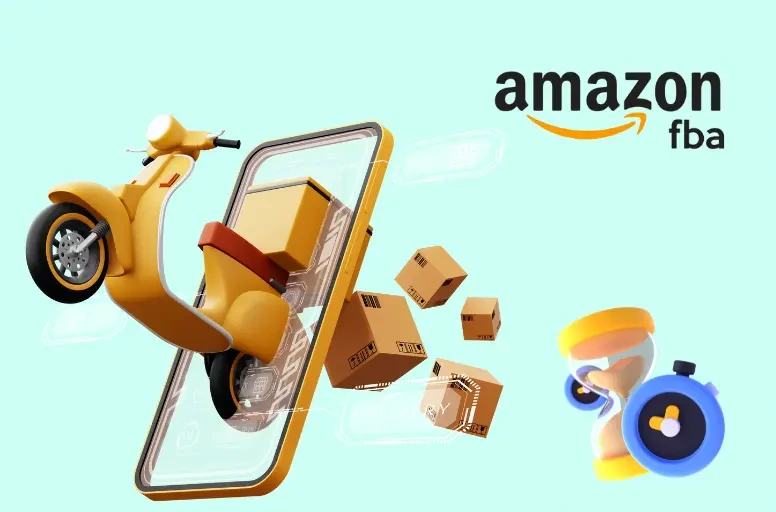
Cons of Amazon FBA
However, there are notable disadvantages to using Amazon FBA. The most significant concern is the array of fees associated with the service, including storage, fulfillment, and referral fees.
- High fees. Amazon FBA incurs various fees, including storage, fulfillment, and referral fees, which can significantly cut into your profit margins. Typically, the combined FBA and referral fees can amount to 30-40% of your product’s selling price. Therefore, to know “Is Amazon FBA profitable?” you need to use Amazon FBA fee calculator (aka Amazon Revenue Calculator).
- Aged inventory fees. Products stored in Amazon warehouses for more than 180 days incur additional storage fees. This can be particularly costly for slow-moving items, prompting some sellers to consider alternatives like Fulfillment by Merchant (FBM).
- Customer returns. Amazon’s generous return policy makes it easy for customers to return items, which can lead to higher return rates for some sellers. While this convenience benefits customers, it can create challenges for sellers who must manage returns and potential losses effectively.
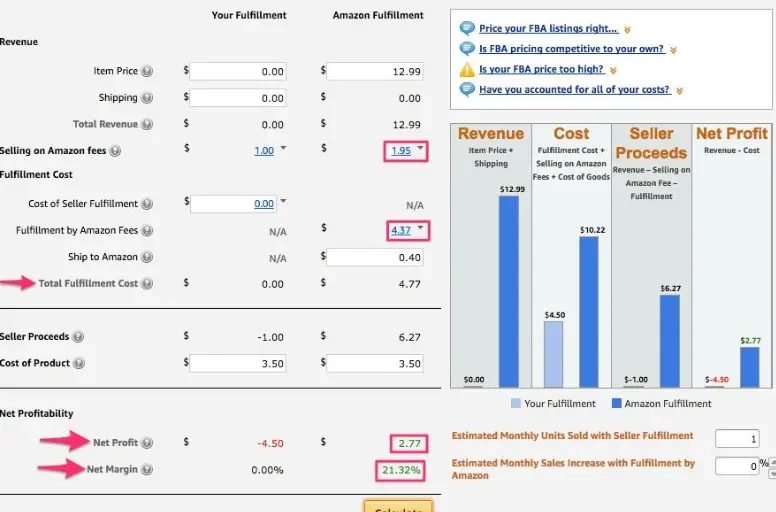
How Long Does FBA Take to Become Profitable?
The timeline for achieving profitability with Amazon FBA (Fulfillment by Amazon) can vary significantly among sellers, influenced by factors such as product selection, market saturation, and marketing strategies.
As of 2024, the majority of Amazon sellers—approximately 58%—become profitable within their first year of operations. This statistic highlights the potential for success in this business model, but it also underscores the importance of strategic planning and execution.
Breaking down the time to profitability further, 22% of sellers report achieving profits within the first three months. An additional 16% see profitability between three to six months, while 20% reach that milestone within six months to a year.
Conversely, 11% of sellers take one to two years to become profitable, and a small fraction, around 2%, report not being profitable even after two years. These figures suggest that while many sellers can see quick returns, others may need to invest more time and effort before realizing profits.
Financially, new Amazon FBA sellers typically start with an investment of less than $5,000, which covers initial inventory, shipping costs, and Amazon fees. The average annual profit for an FBA seller ranges from $12,000 to $300,000, with monthly sales averaging between $1,000 and $25,000.
It’s important to note that about 40% of established sellers report monthly sales in this range. Moreover, most sellers achieve net profit margins between 15% and 20%, with margins above 20% considered excellent.
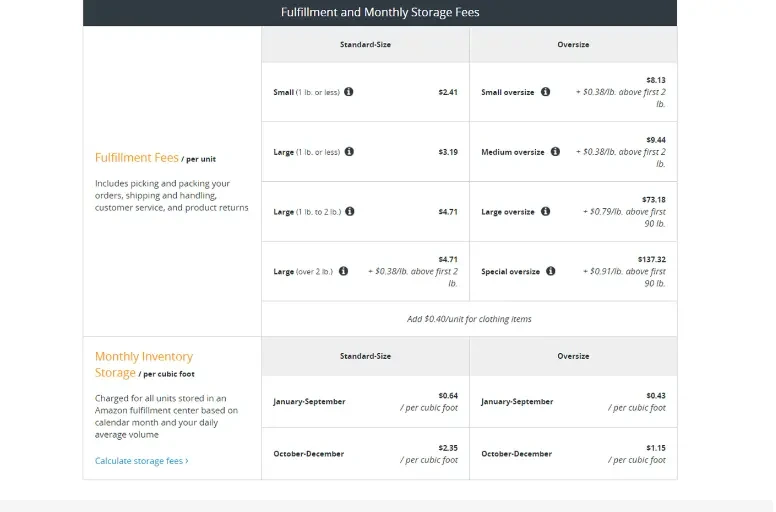
How Much Should I Start Amazon FBA With?
Starting an Amazon FBA (Fulfillment by Amazon) business typically requires a thoughtful financial investment, and the amount can vary based on several factors, including the type of products you plan to sell and your overall business strategy.
Generally, experts recommend having a minimum startup capital of around $5,000 to $10,000 for a stable entry into the market. This range covers essential costs such as inventory, shipping fees, Amazon FBA fees, and other operational expenses.
For those looking to establish a solid foundation, an investment of $7,000 is often suggested. This amount allows for the purchase of initial inventory and covers packaging and shipping costs. Many successful sellers have started with less than $5,000, particularly if they focus on lower-cost items or utilize models like retail arbitrage.
In fact, approximately 40% of Amazon businesses that begin with an investment of less than $10,000 report success, indicating that while challenging, it is feasible to thrive with limited capital.
If you are considering starting with even less—around $1,500 to $2,000—you might explore options like retail arbitrage or dropshipping. These models can minimize upfront costs by allowing you to purchase discounted products from retailers and sell them at a markup on Amazon.
However, starting with such a low budget may limit your product selection and scalability.
Which Types of Products Perform Best with FBA?
The most profitable product categories for Amazon FBA sellers in 2025 include a mix of established favorites and emerging niches. Here’s a summary based on the latest insights:
- Niche products. Focusing on niche markets can yield better results. Products that cater to specific interests or solve particular problems often face less competition and can attract dedicated buyers. For example, specialized LED light bulbs designed for refrigerators may outperform generic options due to targeted marketing.
- Private Label products. Creating your own private label products is frequently recommended as a profitable route. This involves sourcing products from manufacturers, branding them, and selling them under your own label. This strategy allows for higher margins and brand loyalty.
- Low-cost, customizable items: Products that are inexpensive to produce and can be easily customized tend to perform well. Examples include personalized phone cases or home decor items that appeal to specific demographics or interests.
Is Amazon FBA Too Competitive?
Yes, Amazon FBA is competitive, but that doesn’t mean you can’t enter the market. Many sellers express concerns about competing against Amazon itself, particularly when they find it challenging to win the buy box for products that Amazon also sells.
When attempting to undercut Amazon’s prices, sellers often experience price wars that can severely impact their profit margins. This dynamic creates a situation where smaller sellers may feel overwhelmed and unable to compete effectively.
However, success in this environment is possible with strategic planning. Focusing on niche products or unique offerings can help differentiate your brand from the competition. Conducting thorough market research using tools like Jungle Scout or Helium 10 allows sellers to identify less saturated markets and emerging trends. Building a strong brand and utilizing Amazon Brand Registry can also provide protection against direct competition with Amazon.
Additionally, understanding your competitors’ strategies and continuously adapting your approach is crucial. Many successful sellers emphasize the importance of crafting a unique selling proposition (USP) that highlights what makes their products stand out.
How Long Does It Take To Get Selling on Amazon?
To start selling on Amazon, the timeline can vary significantly based on several factors, including your chosen selling method and preparation time. Generally, it takes about 24 hours to set up an Amazon seller account and get verified, but this is just the initial step.
For those opting for retail arbitrage or wholesale methods, you could potentially begin selling within 2 to 3 weeks after finding profitable products and setting up your listings. In contrast, if you’re launching a private label brand, the process typically takes longer. Many sellers report that it can take 3 to 6 months to find suppliers, develop products, and begin selling effectively.
According to recent data, about 48% of sellers launch their first product within three months, while 19% take between six months to a year. It’s crucial to invest time in product research and marketing strategies to ensure your success on the platform. Overall, while the initial setup is quick, building a successful Amazon business requires patience and effort over several months.
Is FBA Worth It: FAQs
- Is Amazon FBA really profitable?
Yes, Amazon FBA may be profitable for sellers. By using FBA, sellers can take advantage of Amazon’s extensive logistics network, which includes:
- Storage
- Packaging
- Shipping
- Customer service
This can help improve the efficiency and reliability of order fulfillment, leading to increased customer satisfaction and potentially higher sales. However, profitability depends on various factors such as:
- Product selection
- Pricing
- Competition
- Marketing strategies
Sellers need to carefully analyze costs, including FBA fees, storage fees, and other expenses, to ensure that their profit margins are sufficient.
- Is Amazon FBA good for beginners?
Yes, Amazon FBA (Fulfillment by Amazon) can be a good option for beginners in eCommerce. It provides a streamlined process for inventory storage, packaging, and shipping, allowing sellers to focus on product selection and marketing. With FBA, sellers can leverage Amazon’s trusted brand and extensive customer base. However, beginners should carefully consider costs, competition, and market research to ensure profitability. It’s important to understand the requirements and benefits of FBA before getting started.
- How much does the average Amazon FBA owner make?
The average income of an Amazon FBA (Fulfillment by Amazon) owner can vary widely depending on various factors such as product selection, pricing, competition, marketing strategies, and overall business performance. While some sellers may achieve significant profits, others may experience more modest earnings or losses. It’s important for FBA owners to carefully analyze costs, optimize their listings, and continuously adapt their strategies to maximize profitability.
- How much can Amazon sellers make?
The income potential for Amazon sellers can vary greatly depending on various factors such as product selection, pricing, competition, and marketing strategies. While some sellers may achieve significant profits, others may earn more modest amounts or even experience losses. It’s important for sellers to carefully analyze costs, optimize their listings, and continuously adapt their strategies to maximize profitability. No fixed amount can be stated as the average income for Amazon sellers.
So, Is Amazon FBA Worth It?
In conclusion, selling on Amazon FBA remains a worthwhile endeavor for many entrepreneurs. While competition is intensifying from emerging platforms like Temu and Shein, the demand for online shopping continues to thrive, with 51% of consumers starting their product searches on Amazon. This indicates that there is still significant potential for sellers to capture market share and drive sales.
Ultimately, success on Amazon FBA will depend on a seller’s ability to adapt to changing market dynamics, optimize their product offerings, and leverage the advantages that FBA provides. For those willing to navigate these challenges, the opportunity for profitability and growth on Amazon remains strong in 2025 and beyond.
Also, if you want more interesting information and knowledge about top eCommerce platforms, subscribe to our blog.
Finally, for those who want to simplify inventory management, LitCommerce is coming here with you. Contact us now for more information about this tool.

